ARCHIVE FOR THE ‘customer-experience’ CATEGORY
Feb 18, 2022 • Features • Augmented Reality • White Paper • Digital Transformation • customer experience • CareAR
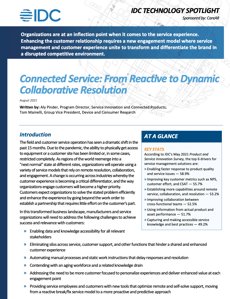
This feature is just one short excerpt from a recent white paper published by CareAR.
www.fieldservicenews.com subscribers can read the full white paper now by hitting the button below.
If you are yet to subscribe you can do so for free by hitting the button and registering for our complimentary subscription tier FSN Standard on a dedicated page that provides you instant access to this white paper PLUS you will also be able to access our monthly selection of premium resources as soo as you are registered.

Data usage note: By accessing this content you consent to the contact details submitted when you registered as a subscriber to fieldservicenews.com to be shared with the listed sponsor of this premium content CareAR who may contact you for legitimate business reasons to discuss the content of this white paper, as per the terms and conditions of your subscription agreement which you opted into in line with GDPR regulations and is an ongoing condition of subscription.
Considering CareAR, a Xerox Company
CareAR provides a full suite of end-to-end service experience management (SXM) SaaS-based solutions across service, support, sales, and marketing workflows. The CareAR SXM platform makes expertise accessible instantly for customers, employees, and field workers through live visual AR and artificial intelligence (AI) interactions, instructions, and insights as part of a seamless digital workflow experience. CareAR helps bridge the skills gap and accelerate knowledge transfer through augmenting intelligence while providing greater efficiencies, customer outcomes, and safety as well as reduced carbon emissions.
AI/AR-Powered Service ExperiencesCareAR delivers critical context through real-time visual AR interactions, instructions, and intelligence as part of a seamless digital workflow. The CareAR SXM platform takes advantage of smartphones, tablets, and other devices such as smart glasses and drones to capture real-time video for a personalized perspective of every support engagement, linking a remote expert with a customer or a field technician. Graphical guidance such as a laser pointer, circles, and annotations is overlaid on video in 3D to create an immersive AR experience. Rear-facing smartphone camera use focuses on the target issue while eliminating visible video lag or latency. Computer vision automatically frames the area being considered. Digital information is overlaid on real-time video with "stickiness" to its intended area despite movement, which is a defining CareAR characteristic. As a result, the real-world visual is blended with digitally created images to focus attention with graphical direction to improve service and support outcomes.
Contextualization of Content
CareAR Insight delivers contextual data for greater insights into specific assets, issues, and resolutions. By combining AI with AR, CareAR augments the intelligence of service teams to bridge knowledge gaps and uncover insights into hidden problems. The technology helps the service professional get to the root cause of the issue faster by accessing a full view of the asset's data, reducing the duration of a service call, and eliminating costly repeat visits.
Self-Solve Instructions
CareAR provides a simple but powerful tool to create AR-enabled visual instructions and make information accessible to users. AI-powered computer vision is used to access the collective intelligence of multiple users and then put that information into action. CareAR merges contextual video data with interactive guides to increase a user's level of knowledge, whether the user is a field service technician looking to fill a gap in knowledge or skills or a customer needing instruction to assemble a device after unboxing.
Integrated Workflow
CareAR natively integrates with service management platforms such as ServiceNow across customer, field, and IT service management. This end-to-end integration allows field technicians to capture images and recordings during service sessions. That content is automatically saved in the originating work order, case, incident, or knowledge base, eliminating a series of steps to enhance knowledge transfer and ensure proof of work completion or compliance.
SXM Use Cases
AR guidance generated by a remote expert or in the form of self-serve instructions is the most common way AR value is realized. Primary use cases for the company's solution include:
- Field Service. Supporting technicians paired with an expert located elsewhere using AR is a common use case. Multiple experts or field service technicians may be included in an AR session. Key drivers for this case include:
-
Skills. Experts are increasingly in short supply. Field technicians are frequently junior level and/or contractors lacking experience.
-
Effectiveness and efficiency. Reduced time to resolve, improved first-time fix rates, reduced truck rolls, and enhanced customer experience are examples of key field service metrics that benefit from the technology.
-
Integration. Silos of data lead to disconnected outcomes. Integration across data sources enables intelligence on AR effectiveness, frequency of uses, and CRM connectivity to establish a single view of the data for the field service team.
-
-
Customer Service. Contact center and customer support agents work with customers to resolve issues faster. This is an AR use case that moves the needle on customer experience with emotional impact and enhanced engagement. Key drivers for this case include:
-
Internet of Things (IoT). Home devices are becoming more connected and complex. Customers require assistance to overcome language and jargon barriers for effective diagnosis and resolution.
-
Customer experience. Customers increasingly prefer to self-serve. But when they fail, they call. When they call, expectations are high and commonly emotionally charged.
-
Fewer technician visits. Remote assistance reduces technician visits, which many customers resisted during the pandemic and still prefer to avoid.
-
-
Industry 4.0. AR-enhanced procedural instructions aid employees with assembly and troubleshooting and also help QA staff increase their own efficiency and effectiveness. Key case drivers include:
-
Hands free. Wearables tend to play a more significant role in this use case.
-
Step by step. AR guidance and insights are emphasized. Remote expert support also plays a role, especially with complex environments.
-
Integration. Instrumentations and procedural adherence are frequently required.
-
Challenges
Technologies to enable collaboration and real-time remote support are moving beyond the pilot stage for many organizations, especially due to the disruption to the market in 2020. However, any innovative technology, regardless of market shifts, will face challenges in adoption, deployment, and full utilization. Technology firms such as CareAR must address three primary challenges in the market:
-
Historically, the adoption of innovative technologies in the customer support and field service market has moved slowly from concept to pilot to scalable production. Establishing a clear adoption path that solves various use cases will help CareAR navigate pilot purgatory.
-
Service technology and digital transformation sometimes take a back seat to other digital investments within the manufacturing and service industry. This trend is changing as the impact and importance of the service experience rise in the hierarchy of strategic initiatives, but it is still a challenge.
-
Companies such as CareAR must improve the content creation and best practice sharing, validation, relevance, and updating process. Technology to collaborate and capture knowledge is only as good as the content being shared.
The service experience companies deliver to customers is at an inflection point whereby customers demand immersive experiences, collaboration with the service organization when necessary, and resolution on a first call or visit. Manufacturers and service organizations should consider the following actions as they digitally transform and look to engage customers, field and customer support teams, and partners differently:
-
Enable dynamic service resolution models where physical presence is not the only path to addressing a failure or customer issue
-
Foster an environment of real-time collaboration and best practice sharing between the service team and with the customer
-
Move beyond efficiency to prioritize customer and field service employee experiences and outcomes
-
Hasten digital transformation as reactive service and failed first service visits lead to lower customer satisfaction and lost future revenue.
Remember that AR technology is a starting point and not the end goal. The ability to intelligently engage, collaborate, and resolve will be the differentiator of the future.
Field Service News subscribers can access the full white paper sponsored by CareAR and written by Ali Pinder, Program Director, Service Innovation and Connected Products at IDC, and Tom Mainelli, IDC's Group Vice President, Device and Consumer Research, by clicking on the button below.
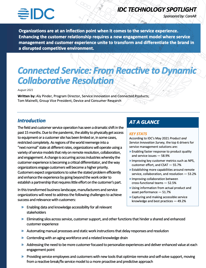
This feature is just one short excerpt from a recent white paper we published in partnership with Exel Computer Systems..
www.fieldservicenews.com subscribers can read the full white paper now by hitting the button below.
If you are yet to subscribe you can do so for free by hitting the button and registering for our complimentary subscription tier FSN Standard on a dedicated page that provides you instant access to this white paper PLUS you will also be able to access our monthly selection of premium resources as soo as you are registered.
 Data usage note: By accessing this content you consent to the contact details submitted when you registered as a subscriber to fieldservicenews.com to be shared with the listed sponsor of this premium content CareAR who may contact you for legitimate business reasons to discuss the content of this white paper, as per the terms and conditions of your subscription agreement which you opted into in line with GDPR regulations and is an ongoing condition of subscription.
Data usage note: By accessing this content you consent to the contact details submitted when you registered as a subscriber to fieldservicenews.com to be shared with the listed sponsor of this premium content CareAR who may contact you for legitimate business reasons to discuss the content of this white paper, as per the terms and conditions of your subscription agreement which you opted into in line with GDPR regulations and is an ongoing condition of subscription.
Further Reading:
- Read more about Digital Transformation @ www.fieldservicenews.com/digital-transformation
- Read more about Customer Experience @ www.fieldservicenews.com/customer+experience
- Learn more about CareAR @ carear.com
- Follow CareAR on Twitter @ twitter.com/carear_com
- Connect with CareAR on LinkedIn @ www.linkedin.com/carear/
Feb 11, 2022 • Features • White Paper • Digital Transformation • Data Management • customer experience • CareAR

This feature is just one short excerpt from a recent white paper published by CareAR.
www.fieldservicenews.com subscribers can read the full white paper now by hitting the button below.
If you are yet to subscribe you can do so for free by hitting the button and registering for our complimentary subscription tier FSN Standard on a dedicated page that provides you instant access to this white paper PLUS you will also be able to access our monthly selection of premium resources as soo as you are registered.

Data usage note: By accessing this content you consent to the contact details submitted when you registered as a subscriber to fieldservicenews.com to be shared with the listed sponsor of this premium content CareAR who may contact you for legitimate business reasons to discuss the content of this white paper, as per the terms and conditions of your subscription agreement which you opted into in line with GDPR regulations and is an ongoing condition of subscription.
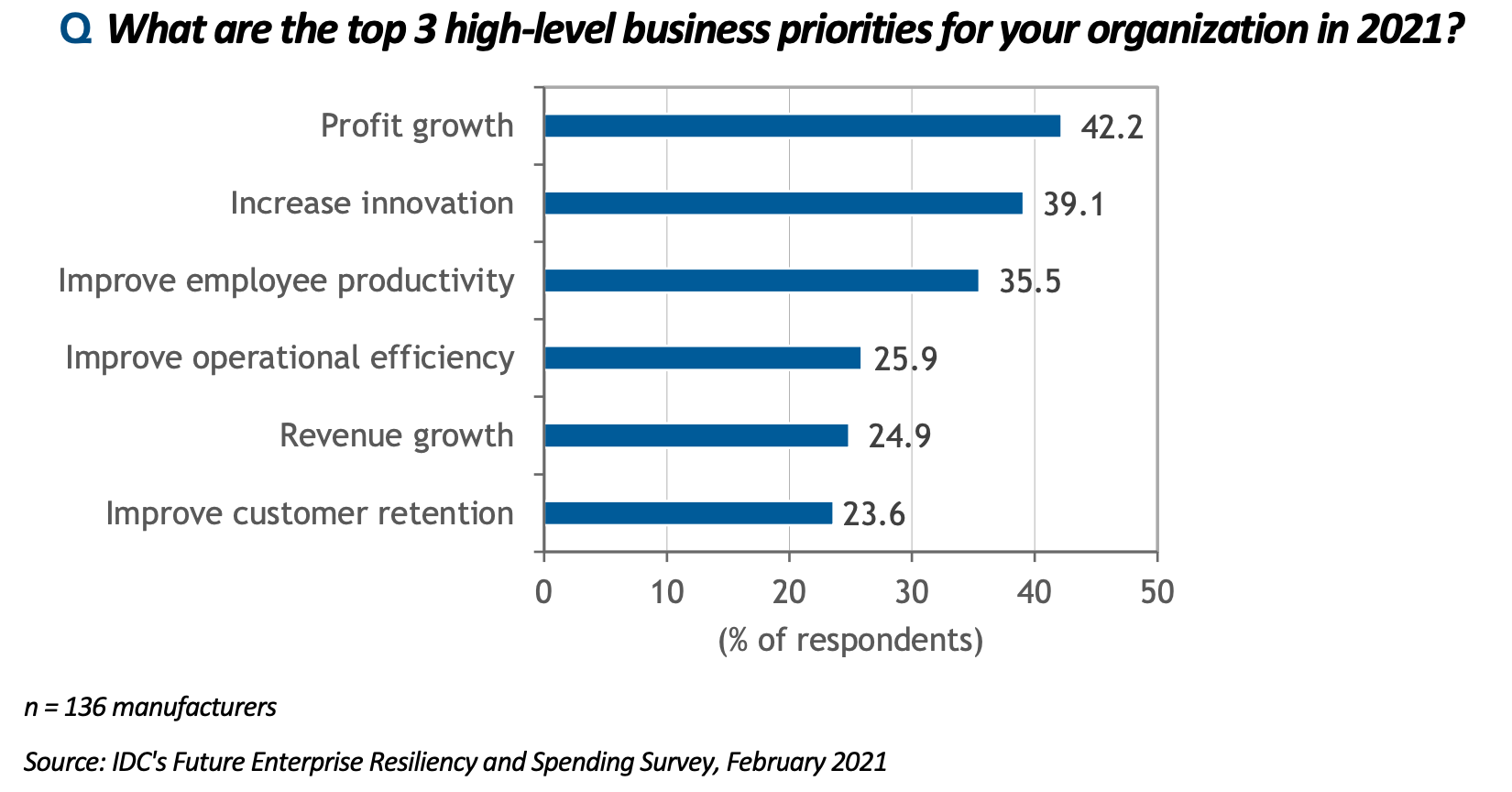
As manufacturers and service organizations shift their business and customer engagement models, they must address a few areas to truly bring together the service experience and the customer experience:
-
Establish the knowledge capabilities to address reactive, proactive, and self-service needs. No one model will be in place in all situations, and organizations will need to be nimble to adjust to the need efficiently.
-
Deliver support and resolution for both simple and complex work with a diverse workforce with various degrees of expertise. Customers want a resolution to ensure that their operation or experience is not negatively impacted by downtime. To provide this level of service, organizations need to solve problems of varying complexity. What has changed is this level of response needs to happen on the first visit because extended downtime due to a lack of expertise to solve a problem is unacceptable.
-
Harness the convergence of the customer experience with the service and support experiences, strengthening the partnership with customers. Data must flow across the organization, and manufacturers are beginning to understand they need to make data accessible across functional teams to offer an integrated customer experience. Customer centricity has shifted the focus of manufacturers to prioritize the needs of the customer and the service employee, providing them with the visibility to go beyond standard engagements to deliver "wow" experiences. Meeting service-level agreements (SLAs) is table stakes; organizations need to go beyond the standard contract to connect the service experience with other activities such as sales, marketing, and product improvements.
-
Leverage innovative technologies such as augmented reality (AR) to drive innovation and an enhanced customer experience. The pandemic helped drive a rapid shift where AR moved from being a cool future technology to a technology that's delivering tangible value around remote service, remote collaboration between a service worker and a customer, and self-service experiences with technical support. Nearly three-fourths (72.2%) of manufacturers in IDC's May 2021 Product and Service Innovation Survey pointed to AR as important or very important to their current efforts around service innovation.
AR technology has evolved dramatically over the past few years. The pandemic drove a big part of that evolution, as companies adapted to an ever-evolving set of circumstances on the ground. In a 2021 survey of AR adopters, IDC found that the top 3 benefits the technology brought to their businesses were increased worker efficiency, improved real-time collaboration, and improved knowledge transfer between expert and novice workers.
Another driving force behind the current uptick in AR adoption is that an increasing number of companies are finding ways to integrate AR capabilities into their existing workflows and back-end systems. Any organization looking at new technologies to become more dynamic and less reactive must consider the impact on its current processes to leverage existing systems and partners to drive improvements without creating disruption.
Field Service News subscribers can access the full white paper sponsored by CareAR and written by Ali Pinder, Program Director, Service Innovation and Connected Products at IDC, and Tom Mainelli, IDC's Group Vice President, Device and Consumer Research, by clicking on the button below.

This feature is just one short excerpt from a recent white paper we published in partnership with Exel Computer Systems..
www.fieldservicenews.com subscribers can read the full white paper now by hitting the button below.
If you are yet to subscribe you can do so for free by hitting the button and registering for our complimentary subscription tier FSN Standard on a dedicated page that provides you instant access to this white paper PLUS you will also be able to access our monthly selection of premium resources as soo as you are registered.
 Data usage note: By accessing this content you consent to the contact details submitted when you registered as a subscriber to fieldservicenews.com to be shared with the listed sponsor of this premium content CareAR who may contact you for legitimate business reasons to discuss the content of this white paper, as per the terms and conditions of your subscription agreement which you opted into in line with GDPR regulations and is an ongoing condition of subscription.
Data usage note: By accessing this content you consent to the contact details submitted when you registered as a subscriber to fieldservicenews.com to be shared with the listed sponsor of this premium content CareAR who may contact you for legitimate business reasons to discuss the content of this white paper, as per the terms and conditions of your subscription agreement which you opted into in line with GDPR regulations and is an ongoing condition of subscription.
Further Reading:
- Read more about Digital Transformation @ www.fieldservicenews.com/digital-transformation
- Read more about Customer Experience @ www.fieldservicenews.com/customer+experience
- Learn more about CareAR @ carear.com
- Follow CareAR on Twitter @ twitter.com/carear_com
- Connect with CareAR on LinkedIn @ www.linkedin.com/carear/
Feb 04, 2022 • Features • White Paper • Digital Transformation • Data Management • customer experience • CareAR

This feature is just one short excerpt from a recent white paper published by CareAR.
www.fieldservicenews.com subscribers can read the full white paper now by hitting the button below.
If you are yet to subscribe you can do so for free by hitting the button and registering for our complimentary subscription tier FSN Standard on a dedicated page that provides you instant access to this white paper PLUS you will also be able to access our monthly selection of premium resources as soo as you are registered.

Data usage note: By accessing this content you consent to the contact details submitted when you registered as a subscriber to fieldservicenews.com to be shared with the listed sponsor of this premium content CareAR who may contact you for legitimate business reasons to discuss the content of this white paper, as per the terms and conditions of your subscription agreement which you opted into in line with GDPR regulations and is an ongoing condition of subscription.
Manufacturers and service organizations need to manage various priorities to ensure they can survive, thrive, and excel in a competitive environment where customer expectations continue to rise.

BENEFITS
Service management with field technicians — and directly with customers — has long been held back by a reactive break/fix model. In this model, customers have to notify the service organization of a failure or a break. The field service team then must attempt to solve the issue with limited information gleaned from the customer or historical data from the last service visit. This process typically involves dispatching a service technician or engineer to a customer site to validate a diagnosis, often leading to a secondary or tertiary service call. Real-time visibility into the product or asset with detailed collaborative capabilities can transform the service and customer experience.
The shift from reactive service models to proactive service experiences has an impact that transcends operational efficiency to enhance the customer relationship. Establishing an operating model where the customer and the service employee are at the heart of the service experience is transformative and can be a true industry differentiator. This framework establishes a new partnership of shared goals, outcomes, and experiences that optimize service and deliver new value.
Connected service insights are part of the innovative future for manufacturers and service organizations. A few of the most impactful benefits derived from this approach are:
- Having the right content and insights at the point of need, which speeds up service resolution and avoids the need to sift through irrelevant manuals and work instructions with reactive and proactive service interactions
-
Capturing and then sharing institutional knowledge, which minimizes the impact of an aging or retiring field and service workforce
-
Improving increased first-time fix and lower mean-time-to-resolution metrics, which enhances the customer experience through proactive support
-
Avoiding unnecessary truck rolls that impact fuel usage, emissions, and safety, which helps improve operations
-
Establishing an emotional and personalized bond between the service team and the customer through contextual awareness of the problem at hand, integration of a full view of the customer, and self-service experiences
TRENDS
Manufacturers and service organizations are racing to digitally transform their business operations to deliver a new experience to customers, enhancing both the brand and the engagement model. Competition has forced manufacturers and service organizations to rethink how they strengthen bonds with customers, which wasn't historically necessary as they owned the customer life cycle. In IDC's November 2020 COVID-19 Impact on IT Spending Survey, nearly half of manufacturers said they prioritize creating new digital products and services and now look to deliver digital-first customer experiences — 46.2% and 31.9%, respectively
Field Service News subscribers can access the full white paper sponsored by CareAR and written by Ali Pinder, Program Director, Service Innovation and Connected Products at IDC, and Tom Mainelli, IDC's Group Vice President, Device and Consumer Research, by clicking on the button below.

This feature is just one short excerpt from a recent white paper we published in partnership with Exel Computer Systems..
www.fieldservicenews.com subscribers can read the full white paper now by hitting the button below.
If you are yet to subscribe you can do so for free by hitting the button and registering for our complimentary subscription tier FSN Standard on a dedicated page that provides you instant access to this white paper PLUS you will also be able to access our monthly selection of premium resources as soo as you are registered.
 Data usage note: By accessing this content you consent to the contact details submitted when you registered as a subscriber to fieldservicenews.com to be shared with the listed sponsor of this premium content CareAR who may contact you for legitimate business reasons to discuss the content of this white paper, as per the terms and conditions of your subscription agreement which you opted into in line with GDPR regulations and is an ongoing condition of subscription.
Data usage note: By accessing this content you consent to the contact details submitted when you registered as a subscriber to fieldservicenews.com to be shared with the listed sponsor of this premium content CareAR who may contact you for legitimate business reasons to discuss the content of this white paper, as per the terms and conditions of your subscription agreement which you opted into in line with GDPR regulations and is an ongoing condition of subscription.
Further Reading:
- Read more about Digital Transformation @ www.fieldservicenews.com/digital-transformation
- Read more about Customer Experience @ www.fieldservicenews.com/customer+experience
- Learn more about CareAR @ carear.com
- Follow CareAR on Twitter @ twitter.com/carear_com
- Connect with CareAR on LinkedIn @ www.linkedin.com/carear/
Jan 28, 2022 • Features • White Paper • Digital Transformation • Data Management • customer experience • CareAR
Organizations are at an inflection point when it comes to the service experience. In this new series of excerpts from a recent IDC white paper, sponsored by CareAR and now available at Field Service News, we discuss how service organisations can...
Organizations are at an inflection point when it comes to the service experience. In this new series of excerpts from a recent IDC white paper, sponsored by CareAR and now available at Field Service News, we discuss how service organisations can enhance customer relationships using a new engagement model where service management and customer experience unite to transform and differentiate the brand in a disrupted competitive environment.

This feature is just one short excerpt from a recent white paper published by CareAR.
www.fieldservicenews.com subscribers can read the full white paper now by hitting the button below.
If you are yet to subscribe you can do so for free by hitting the button and registering for our complimentary subscription tier FSN Standard on a dedicated page that provides you instant access to this white paper PLUS you will also be able to access our monthly selection of premium resources as soo as you are registered.

Data usage note: By accessing this content you consent to the contact details submitted when you registered as a subscriber to fieldservicenews.com to be shared with the listed sponsor of this premium content CareAR who may contact you for legitimate business reasons to discuss the content of this white paper, as per the terms and conditions of your subscription agreement which you opted into in line with GDPR regulations and is an ongoing condition of subscription.
The field and customer service operation has seen a dramatic shift in the past 15 months. Due to the pandemic, the ability to physically get access to equipment or a customer site has been limited or, in some cases, restricted completely. As regions of the world reemerge into a "next normal" state at different rates, organizations will operate using a variety of service models that rely on remote resolution, collaboration, and engagement. A change is occurring across industries whereby the customer experience is becoming a critical differentiator, and the way organizations engage customers will become a higher priority. Customers expect organizations to solve the stated problem efficiently and enhance the experience by going beyond the work order to establish a partnership that requires little effort on the customer's part.
In this transformed business landscape, manufacturers and service organizations will need to address the following challenges to achieve success and relevance with customers:
-
» Enabling data and knowledge accessibility for all relevant stakeholders
-
» Eliminating silos across service, customer support, and other functions that hinder a shared and enhanced customer experience
-
» Automating manual processes and static work instructions that delay responses and resolution
-
» Contending with an aging workforce and a related knowledge drain
-
» Addressing the need to be more customer focused to personalize experiences and deliver enhanced value at each engagement point
-
» Providing service employees and customers with new tools that optimize remote and self-solve support, moving from a reactive break/fix service model to a more proactive and predictive approach
KEY STATS
According to IDC's May 2021 Product and Service Innovation Survey, the top 6 drivers for service management solutions are:
-
» Enabling faster response to product quality and service issues — 58.9%
-
» Improving key customer metrics such as NPS, customer effort, and CSAT — 55.7%
-
» Establishing more capabilities around remote service, collaboration, and resolution — 53.2%
-
» Improving collaboration between cross-functional teams — 52.5%
-
» Using information from actual product and asset performance — 51.7%
-
» Capturing and making accessible service knowledge and best practices — 49.2%
Watch out for the next feature next week where we discuss some of the top business priorities for manufacturers and service organizations in this "next normal" environment.
Field Service News subscribers can access the full white paper sponsored by CareAR and written by Ali Pinder, Program Director, Service Innovation and Connected Products at IDC, and Tom Mainelli, IDC's Group Vice President, Device and Consumer Research, by clicking on the button below.

This feature is just one short excerpt from a recent white paper we published in partnership with Exel Computer Systems..
www.fieldservicenews.com subscribers can read the full white paper now by hitting the button below.
If you are yet to subscribe you can do so for free by hitting the button and registering for our complimentary subscription tier FSN Standard on a dedicated page that provides you instant access to this white paper PLUS you will also be able to access our monthly selection of premium resources as soo as you are registered.
 Data usage note: By accessing this content you consent to the contact details submitted when you registered as a subscriber to fieldservicenews.com to be shared with the listed sponsor of this premium content CareAR who may contact you for legitimate business reasons to discuss the content of this white paper, as per the terms and conditions of your subscription agreement which you opted into in line with GDPR regulations and is an ongoing condition of subscription.
Data usage note: By accessing this content you consent to the contact details submitted when you registered as a subscriber to fieldservicenews.com to be shared with the listed sponsor of this premium content CareAR who may contact you for legitimate business reasons to discuss the content of this white paper, as per the terms and conditions of your subscription agreement which you opted into in line with GDPR regulations and is an ongoing condition of subscription.
Further Reading:
- Read more about Digital Transformation @ www.fieldservicenews.com/digital-transformation
- Read more about Customer Experience @ www.fieldservicenews.com/customer-experience
- Learn more about CareAR @ carear.com
- Follow CareAR on Twitter @ twitter.com/carear_com
- Connect with CareAR on LinkedIn @ www.linkedin.com/carear/
Jan 07, 2022 • Features • Digital Transformation • technology • Aquant • GLOBAL • customer experience
In this article, we discuss the findings of Aquant's 2022 Service Intelligence Benchmark Report and look at some key observations about service performance from the customer's perspective.
In this article, we discuss the findings of Aquant's 2022 Service Intelligence Benchmark Report and look at some key observations about service performance from the customer's perspective.
The last two years were extremely difficult for the service industry—and not just because of the pandemic. While COVID-19 certainly played a role in exacerbating the issues, workforce labor shortages, complicated equipment, and increasingly reactive service were also challenges faced by many service providers.
And yet, according to the data analyzed in Aquant’s 2022 Service Intelligence Benchmark Report, there is another overarching theme to be found: the way organizations provide service today is not in tune with customer expectations. Six million tickets later, the report reveals some key observations about service performance from the customer’s perspective.
Our report measures data across:
- 76 organizations, including service divisions within OEMs and third-party service organizations across manufacturing, medical devices, capital equipment, HVAC, commercial appliances, and more
- More than 6 million work orders
- More than 31,000 technicians
- $7 billion total in service costs
- An average of 3 years of service data per company
We analyzed:
- How service organizations and their workforce measure up against industry benchmarks
- Why hitting your KPIs rarely equates to outstanding customer experiences
- Why a missed First Time Fix (FTF) event leads to a spiraling negative impact
- How a workforce shortage has exacerbated the existing skills gap between the heroes (highest performers) and challengers (lowest performers) within each organization
Here's what we discovered:
- Service organizations suffer from a wide customer experience (CX) gap. First Time Fix (FTF) rates are one of the biggest contributors to CX gaps, or the difference between what customers expect and what your organization delivers. Our analysis shows that companies who measure FTF rates in 7-day or 14-day windows have artificially inflated FTF rates, and are setting the stage for a wide experience gap. That's the perfect setup for frustrating customer experiences. The moral of the story: a few metrics can’t provide the entire picture—and it’s time to look at experience as a whole.
- The knowledge gap between heroes and challenges is becoming more expensive. In 2021, service organizations faced even larger hiring challenges than in the past. This has left the industry with tens of thousands of unfilled jobs, and caused service costs to increase.
- The bottom quarter of the workforce costs organizations 84% more than the top quarter. That’s 4% higher than last year.
- The top 20% of the workforce (service heroes) has a 75% FTF rate.
- The bottom 20% of the workforce (service challengers) has a FTF rate of 59%.
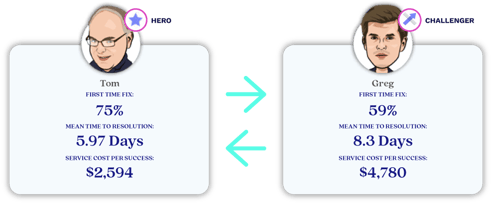
- It’s possible to overcome these challenges. Your data tells a bigger story—if you know what to look for. Looking beyond your KPIs will help you tailor service for every customer, provide a better CX, upskill your team, and cut costs.
It’s time to understand your business on a much deeper level than ever before. Download Aquant’s 2022 Benchmark Report to see how you stack up to your peers, uncover the stories that your KPI averages are telling, and start seeing your service from the customer’s perspective.
Further Reading:
- Read more about Digital Transformation @ www.fieldservicenews.com/digital-transformation
- Read more about Aquant on Field Service News @ www.fieldservicenews.com/aquant
- Download Aquant's 2022 Benchmark Report @ www.aquant.io/resources/benchmark-report/
- Find out more about Aquant @ www.aquant.io
- Follow Aquant on Twitter @ twitter.com/Aquant_io
- Follow Aquant on LinkedIn @ www.linkedin.com/aquant.io
Dec 03, 2021 • Features • Mize • Parts Pricing and Logistics • GLOBAL • customer experience
Durable goods manufacturers have long played a part in the circular business economy, placing particular emphasis on improving productivity and streamlining reverse logistic supply chain processes to achieve time- and cost-saving benefits.
Durable goods manufacturers have long played a part in the circular business economy, placing particular emphasis on improving productivity and streamlining reverse logistic supply chain processes to achieve time- and cost-saving benefits.
While a laser focus on operational efficiency is important in reverse logistics, it doesn't always optimize the most important component in the equation: the customer experience. The old adage that the customer is always right is especially true when something goes wrong, a critical repair is needed to keep your customer's business moving forward, or a customer needs to know when they can expect to receive what you've promised.
Optimizing reverse logistics for customer experience can make the difference between a customer that experiences momentary frustration and one who seeks out a competitor.
Fortunately, durable goods manufacturers are capturing the opportunity to improve the customer experience at every touchpoint, including key points in the reverse logistics supply chain (RLSC). According to a whitepaper by The Blumberg Advisory Group and Mize, durable goods manufacturers have "moved beyond looking internally within their organizations to find ways to cut costs and streamline operations. They are now looking externally at how customer-facing activities may impact the ability to scale and grow their reverse logistics supply chain operations."
THE COMPLEXITY OF THE RLSC IN DURABLE GOODS MANUFACTURING
There's no shortage of complexity in the reverse logistics supply chain and the challenges can be daunting—and resource intensive. In 2020, Statista reported more than $636 billion in reverse logistics spending. They predict that number will exceed $958 billion before the end of the decade.
That complexity is inherent in durable goods manufacturing and compounded by the legacy ERP and supply chain management (SCM) solutions that lack the capabilities to overcome these challenges. Legacy systems often comprise disparate applications, which lack the business logic and process flow required to provide critical feature-functionality, robust reporting, and analytic capabilities.
For instance, a lack of integration can make it challenging for original equipment manufacturers, channel partners, and service providers to forecast necessary resources, like labor and parts, and scale-up in time when needed. It can also prevent seamless data gathering and transfer, causing channel partners to face inaccurate/delayed reporting and gaps between returns shipment and credit issuance. And for the customer, a disjointed RLSC almost always creates a frustrating return process due to issues like fragmented customer service, lack of repair status updates, and extended wait times.
THE COMPLEXITY OF THE RLSC IN DURABLE GOODS MANUFACTURING
The right depot repair solution will help to reduce operational costs, optimize service experience, and build stronger customer relationships. Depot repair is a critical component of RLSC that focuses on streamlining and automating the end-to-end repair process, from initiating a customer service request to delivering the repaired product back to the customer.
Mize Depot Repair Management is designed to fix inefficient processes at centralized repair depots, shortening product downtime, raising technician productivity, and lowering parts inventory costs on repair orders. In addition, its cloud-based digital platform improves visibility for all stakeholders, making it easy to communicate with customers and build stronger customer relationships.
DEPOT REPAIR IMPROVES VISIBILITY AND TRANSPARENCY FOR A BETTER CX
Customer expectations and supply chain obstacles evolve consistently, which means your approach needs to evolve as well. Mize offers a Service Lifecycle Management solution, including Depot Repair Management, that connects manufacturers to their end customers and everyone in between, reducing operational costs and maximizing the lifetime value of customer relationships.
Download Mize latest whitepaper to learn more about how leading organizations are optimizing the reverse logistics supply chain and better meet customer needs.
Further Reading:
- Read more about Parts, Pricing & Logistics @ www.fieldservicenews.com/parts-pricing-and-logistics
- Learn more about Mize on Field Service News @ www.fieldservicenews.com/blog/all-about-mize
- Read more articles and news about Mize on Field Service news @ www.fieldservicenews.com/mize
- Find out more about Mize @ www.m-ize.com
- Read more on Mize's blog @ www.m-ize.com/blog
- Follow Mize on Twitter @ twitter.com/mizecom
Nov 26, 2021 • Features • White Paper • FieldAware • Leadership and Strategy • customer experience • customer success
In this final feature from a recent white paper we published in partnership with FieldAware, we discuss if customer satisfaction metrics are suitable to identify a measure of success in a servitized or customer success-based service model.
In this final feature from a recent white paper we published in partnership with FieldAware, we discuss if customer satisfaction metrics are suitable to identify a measure of success in a servitized or customer success-based service model.
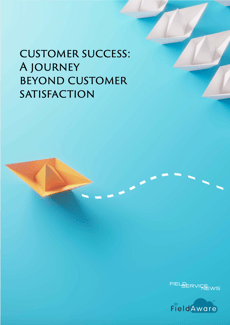
This feature is just one short excerpt from a recent white paper we published in partnership with FieldAware.
www.fieldservicenews.com subscribers can read the full white paper now by hitting the button below.
If you are yet to subscribe you can do so for free by hitting the button and registering for our complimentary subscription tier FSN Standard on a dedicated page that provides you instant access to this white paper PLUS you will also be able to access our monthly selection of premium resources as soo as you are registered.

Data usage note: By accessing this content you consent to the contact details submitted when you registered as a subscriber to fieldservicenews.com to be shared with the listed sponsor of this premium content FieldAware who may contact you for legitimate business reasons to discuss the content of this white paper, as per the terms and conditions of your subscription agreement which you opted into in line with GDPR regulations and is an ongoing condition of subscription.
Do we need to rethink how we measure success within our organization if we move towards a servitized or customer success focused model? This is something of a complex question, and in many ways, the answer is both yes and no.
From an operational perspective, as we put forward earlier in this paper, broadly what defines operational success in a transactional break-fix service offering largely remains the same definition of success that we would see in a servitized model.
To reiterate, in the traditional break-fix setup, metrics like mean-time-to-repair, first-time-fix-rate, and technician utilization are all indicators of how efficiently the service organization can meet the customer’s external demands and expectations.
In a servitized offering, those same metrics remain vital for ensuring that the field service operation is running at a level of efficiency that makes it both feasible and financially rewarding for the service provider to offer such as solution.
Yet as the Field Service News Research study from late 2019, Understanding the metrics that matter in a rapidly changing field service sector, revealed, of those organizations that had introduced some level of servitization into their service portfolio, over 80% of them had made changes to the KPIs they measure.
Also, remember the statistic we referenced earlier in this paper from that same report- over half (51%) of all field service organizations now placed equal importance on CSAT metrics as they did operational metrics – a statistic that has steadily risen year on year since Field Service News Research began hosting benchmarking studies in this area back in 2013.
Yet, when we think of customer satisfaction metrics, are these suitable to identify a measure of success in a servitized or customer success-based service design model?
Rudimentary statistics such as Net Promoter Score can offer a broad overview of service standards. More detailed tools like customer surveys allow more specific insights to come to the fore, and modern tools such as sentiment analysis can fill in the gaps between the two.
However, all CSAT metrics are the equivalent of driving while looking in the rearview mirror and while valuable indicators, are perhaps not focused enough for the end-goal of defining customer success.
“CSAT metrics are the equivalentof driving while looking in the rearview mirror and while valuable indicators are perhaps not focused enough for the end-goal of defining customer success...”
In earlier sections of this paper, we have touched on how co-creation often lies at the heart of many successful servitization case studies and the potential importance of an onboarding team.
When it comes to defining the core metrics for a customer success-based service model, a critical role of the onboarding team (and also of pre-sales and/or account management) should be to work with the customer to identify a shared set of metrics that will shape how success is defined.
This may require data sets from both organizations to combine a new set of KPIs that allow the service provider to ensure they meet the requirements. Should these KPIs indicate an issue, then traditional operational KPIs can provide an insight as to why. Meanwhile, broader CSAT metrics can offer an indication of the overall temperature of the service organisations success.
This more complex understanding not only of what success looks like for each customer but also leveraging existing KPIs to ensure that is happening at the macro and granular level, serves once more to re-enforce the importance of not only having the tools to empower effective service delivery but also the critical importance of reporting tools that allow the service provider to quickly and easily keep their finger on the pulse of how the service operation is performing.
In addition, such reporting tools allow the service provider to offer a layer of transparency that is crucial in communicating with the customer. This transparency leads to a relationship founded on trust. In summary, new metrics will evolve, but the old metrics remain vital and access to data is key in all areas.

This feature is just one short excerpt from a recent white paper we published in partnership with FieldAware..
www.fieldservicenews.com subscribers can read the full white paper now by hitting the button below.
If you are yet to subscribe you can do so for free by hitting the button and registering for our complimentary subscription tier FSN Standard on a dedicated page that provides you instant access to this white paper PLUS you will also be able to access our monthly selection of premium resources as soo as you are registered.
 Data usage note: By accessing this content you consent to the contact details submitted when you registered as a subscriber to fieldservicenews.com to be shared with the listed sponsor of this premium content FieldAware who may contact you for legitimate business reasons to discuss the content of this white paper, as per the terms and conditions of your subscription agreement which you opted into in line with GDPR regulations and is an ongoing condition of subscription.
Data usage note: By accessing this content you consent to the contact details submitted when you registered as a subscriber to fieldservicenews.com to be shared with the listed sponsor of this premium content FieldAware who may contact you for legitimate business reasons to discuss the content of this white paper, as per the terms and conditions of your subscription agreement which you opted into in line with GDPR regulations and is an ongoing condition of subscription.
Further Reading:
- Read more about Digital Transformation @ www.fieldservicenews.com/digital-transformation
- Read more about Data Management @ www.fieldservicenews.com/data-management
- Read more about FieldAware on Field Service News @ www.fieldservicenews.com/exel
- Learn more about FieldAware @ www.fieldaware.com
- Follow FieldAware on Twitter @ twitter.com/fieldaware
Nov 25, 2021 • Features • Digital Transformation • Aquant • Covid-19 • customer experience
Aquant, has recently published the 2022 Service Intelligence Benchmark Report, now available at Field Service News, which offers an in-depth analysis of field service performance and customer satisfaction in a year of talent shortage, COVID service...
Aquant, has recently published the 2022 Service Intelligence Benchmark Report, now available at Field Service News, which offers an in-depth analysis of field service performance and customer satisfaction in a year of talent shortage, COVID service pivots, and shifting customer demands. In this final excerpt from the report, we discuss how companies can look beyond KPIs.
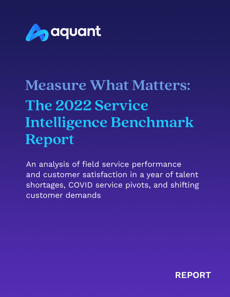
This feature is just one short excerpt from a report published by Aquant
www.fieldservicenews.com subscribers can read the full report now by hitting the button below.
If you are yet to subscribe you can do so for free by hitting the button and registering for our complimentary subscription tier FSN Standard on a dedicated page that provides you instant access to this white paper PLUS you will also be able to access our monthly selection of premium resources as soo as you are registered.
 Data usage note: By accessing this content you consent to the contact details submitted when you registered as a subscriber to fieldservicenews.com to be shared with the listed sponsor of this premium content Aquant who may contact you for legitimate business reasons to discuss the content of this white paper, as per the terms and conditions of your subscription agreement which you opted into in line with GDPR regulations and is an ongoing condition of subscription.
Data usage note: By accessing this content you consent to the contact details submitted when you registered as a subscriber to fieldservicenews.com to be shared with the listed sponsor of this premium content Aquant who may contact you for legitimate business reasons to discuss the content of this white paper, as per the terms and conditions of your subscription agreement which you opted into in line with GDPR regulations and is an ongoing condition of subscription.
The Customer Experience Gap
The Customer Experience Gap shows the difference between what customers expect and what your organization delivers.
Our analysis shows that companies who measure FTF rates in 7-day or 14-day windows are setting the stage for a wide experience gap—which leads to frustrating customer experiences. The moral of the story: a few metrics can’t provide the entire picture. It’s time to look at experience as a whole.
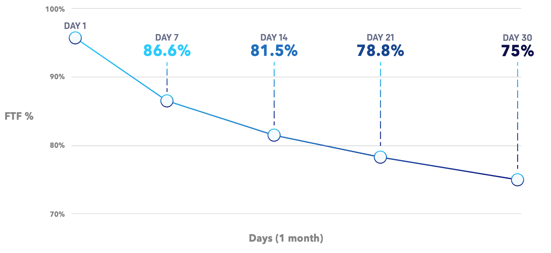
Instead of defining FTF in arbitrary time increments (7 days, 14 days, or 21 days), think about it in terms of the natural service cycle. Our research shows that measuring in 30-day windows strips out false-positive FTF rates.
Understand where your organization falls on the Customer Experience Gap chart.
- If your FTF rate is similar when measured at 7 days and 30 days, you have a small gap.
- If your FTF rate has a wide variation (usually a high rate at 7 days and a low rate at 30 days), you have a large gap.
- If you have a large gap, your team is focused on hitting their numbers instead of focusing on great customer experiences.
Why FTF Rates Vary by Time
When measured in short windows (like 7-day increments), jobs where a technician made an incorrect fix—but got the machine to work temporarily—will be marked as complete. But an incorrect fix is only a temporary measure, and the machine will continue to break down until properly repaired. For instance, a customer may call for service two or three times in a 30-day window. If you only measure in 7-day increments, your dashboard may show you successfully completed three jobs for one customer. In reality, these were three failed visits. This environment also leads to customer escalations and customer complaints that management may deem as “surprise complaints” that they didn’t see coming.
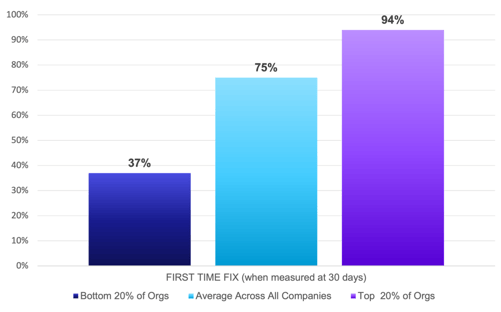
When it comes to service, it’s just as important to maximize the time between events and failures as it is to fix things correctly the first time. The less a customer needs a technician on-site, the better. This means the customer’s needs are being met.
Two Examples of Poor Customer Experiences
Company A: KPIs are not aligned to customer outcomes
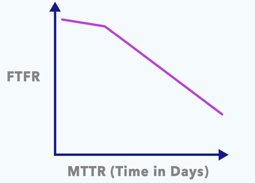
When FTF curves start out flat, it means that the company likely incentivizes high FTF rates over deep problem-solving. That’s shown by the curve getting steeper at the end of a 30-day cycle, indicating that the FTF rate is plummeting.
The key takeaway: Company A is not closely monitoring FTF rate—or there is no incentive to maintain a high rate over a long period of time—leading to poor customer experiences.
Company B: KPIs are not aligned to customer outcomes
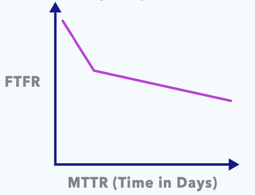
Here, the FTF rate starts out high and eventually flattens out. This may indicate that more preparation, information, or triage was needed before visiting a job site. A return visit would most likely be required to successfully solve the problem. Unlike Company A, Company B eventually solves root problems, but it requires several visits.
The key takeaway: Company B is trying to provide great customer service, but has some limitations that hinder quick and accurate outcomes, such as a lack of prep or an employee knowledge gap.
The Skills Gap - A Profile of the Top and Lowest Performing Organisations
What does the knowledge gap have to do with hitting KPIs?
If there is a large knowledge gap between team members, performance will vary—and so will customers’ experiences. That’s why it’s crucial to make sure that your technicians are equally knowledgeable about the equipment that they service and up-to-date on specific customer preferences.
Determine your team’s skills gap.
To increase your team’s knowledge and success, you must first identify how much of a gap exists between your star technicians (heroes) and underperformers (challengers).
For this report, we calculated the percentage difference between heroes and challengers across all organizations on the following page. We divided it into:
- Above average organizations
- Above performing organizations
- Below average organizations
A Snapshot of high performing and low performing organizations
The top 20% of organizations have a smaller workforce skills gap. A workforce with a more equal knowledge distribution results in more consistent customer experiences.
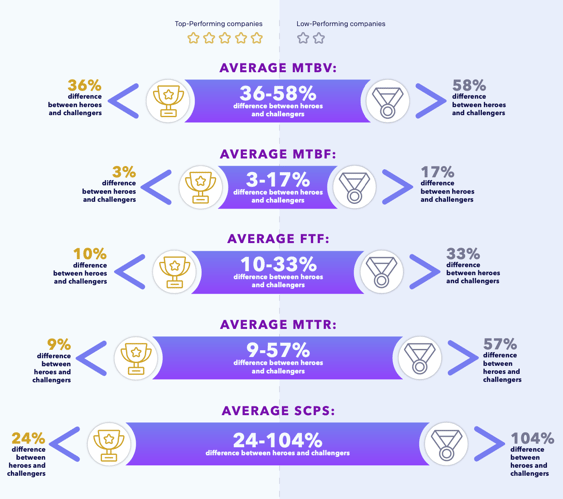
Why the Skills Gap Matters
A bigger distance between heroes and challengers leads to:
- Decrease in customer satisfaction
- Increased workload on your already overburned experts
- Increase in service costs
- Less capacity for organizational resilience
- Negative impact on growth
What's Next?
The service industry is facing unprecedented workforce shortages and increasing customer demands. A better way to overcome these challenges is to understand your business on a much deeper level than you do today so you can tailor service for every customer. Here’s where to start.

This feature is just one short excerpt from a report published by Aquant.
www.fieldservicenews.com subscribers can read the full report now by hitting the button below.
If you are yet to subscribe you can do so for free by hitting the button and registering for our complimentary subscription tier FSN Standard on a dedicated page that provides you instant access to this white paper PLUS you will also be able to access our monthly selection of premium resources as soo as you are registered.
 Data usage note: By accessing this content you consent to the contact details submitted when you registered as a subscriber to fieldservicenews.com to be shared with the listed sponsor of this premium content Aquant who may contact you for legitimate business reasons to discuss the content of this white paper, as per the terms and conditions of your subscription agreement which you opted into in line with GDPR regulations and is an ongoing condition of subscription.
Data usage note: By accessing this content you consent to the contact details submitted when you registered as a subscriber to fieldservicenews.com to be shared with the listed sponsor of this premium content Aquant who may contact you for legitimate business reasons to discuss the content of this white paper, as per the terms and conditions of your subscription agreement which you opted into in line with GDPR regulations and is an ongoing condition of subscription.
Further Reading:
- Read more about Aquant on Field Service News @ www.fieldservicenews.com/aquant
- Read more about Digital Transformation @ www.fieldservicenews.com/digital-transformation
- Read more about Leadership & Strategy @ www.fieldservicenews.com//leadership-and-strategy
- Learn more about Aquant @ www.aquant.io
- Follow Aquant on Twitter @ twitter.com/Aquant_io
Nov 19, 2021 • Features • White Paper • FieldAware • Leadership and Strategy • customer experience • customer success
In this new feature from a recent white paper we published in partnership with FieldAware, we discuss the proper technological infrastructure to ensure that the service operation can operate at maximum efficiency.
In this new feature from a recent white paper we published in partnership with FieldAware, we discuss the proper technological infrastructure to ensure that the service operation can operate at maximum efficiency.

This feature is just one short excerpt from a recent white paper we published in partnership with FieldAware.
www.fieldservicenews.com subscribers can read the full white paper now by hitting the button below.
If you are yet to subscribe you can do so for free by hitting the button and registering for our complimentary subscription tier FSN Standard on a dedicated page that provides you instant access to this white paper PLUS you will also be able to access our monthly selection of premium resources as soo as you are registered.

Data usage note: By accessing this content you consent to the contact details submitted when you registered as a subscriber to fieldservicenews.com to be shared with the listed sponsor of this premium content FieldAware who may contact you for legitimate business reasons to discuss the content of this white paper, as per the terms and conditions of your subscription agreement which you opted into in line with GDPR regulations and is an ongoing condition of subscription.
In the previous section of this paper, we discussed the importance of a new role at the executive level, the CRO, that has oversight of revenue generation and operational efficiency. We also noted that core to this role is an understanding of how the wider business must adapt, support and buy into the broader servitization strategy.
However, perhaps of equal importance is the flow of data across the business.
Often, data is locked away in silos across a business, yet in a servitized model, the seamless movement of data is essential. For example, asset data that provides actionable insight for when service is required, which is the key to unlocking genuinely efficient predictive maintenance, is also exceptionally valuable to the product design teams as it enables them to see the common causes of asset failure and work to resolve these issues.
If accessible to account managers in a customer success model, that same data allows for a level of transparency within the relationship that can be the foundation of trust that is required for deeper, more effective partnerships. Similarly, data flow into the accounting tools used within an organization can significantly reduce the service-to-cash cycle.
To achieve this flow of data, there is an inherent need for critical systems to be able to talk to each other. Two approaches are applicable here. Either a broad platform that encompasses all of the solutions required, such as FSM, ERP and CRM or a focus on best of breed solutions in each of these areas that have easy to use APIs that allow for effortless data flow across the broader system.
While there are arguments that can be put forward for both approaches, largely, it is the latter that is the more common.
There is a degree of complexity in any organization that operates a field service division that means multiple systems in place will be running alongside each other. Replacing all of these with one platform may seem like a straightforward proposition, but in fact, it is a challenge not only from a technology standpoint but also from a change management perspective. Put simply, such a project requires time and resources that many organizations, especially those in the mid-market, just don’t have.
The alternative is not only more achievable for companies of all sizes, but with an open approach to integration, the ability for data flow to drive forward customer success efforts can be harnessed while also having the added advantage of best in class solutions where they are most needed.
When we look at the field service operation, the tools and technology that enable the efficiency required for a servitized approach are now mature and well established, with most field service organizations having at least a legacy form of FSM. Indeed, technology has become a critical aspect of field service operations. As we continue to move towards more advanced service offerings, this symbiosis of processes and technology will only increase.
Ultimately, the ability to deliver effective and efficient field service is firmly wedded to having a technology infrastructure in place.
The pandemic has been shown to have significantly driven investment within digital transformation amongst field service organizations. A study by Field Service News Research, Benchmarking the New Normal from Year Zero, from late 2020 revealed that two-thirds (65%) of field service companies stated that their digital transformation programs had been accelerated since Covid-19.
Technologies that enable remote service delivery and accurate predictive maintenance scheduling such as Augmented Reality and Internet of Things connectivity have rapidly evolved from being at the leading edge of an adoption curve to becoming utilized far more prevalently by field service organizations.
Adoption of such new technologies, of course, only strengthens the argument for core systems such as CRM and FSM to have robust API development.
However, while it is the newer technologies that often dominate the headlines when we consider the shift in focus of servitization and customer success models from being a mere service provider to becoming a genuine partner with a vested interest in the optimal performance of an install base, then the need for a robust technological foundation underpinning field service operations is more crucial than ever before.
From the back-office perspective, tools such as asset management, work order management, scheduling and dispatch and route optimization are now table stakes for field service organizations to deliver effective field service delivery.
Tools that can empower our field service technicians and engineers such as knowledge management, easily accessible forms, alerts and notifications and more, all packaged in an intuitive mobile app, are equally essential.
In addition to these more traditional tools found within an FSM system, customer portals, reporting and insight surfacing tools and invoicing are all becoming increasingly critical to allow the field service organization to operate at a sufficient level of efficiency where servitization or customer success models can be effectively executed.
Having looked at the potential requirements of both management structure and technologies needed to adopt a customer success orientated approach to service strategy, the final question we shall address next week is whether these changes mean that we must also change the way we measure success...

This feature is just one short excerpt from a recent white paper we published in partnership with FieldAware..
www.fieldservicenews.com subscribers can read the full white paper now by hitting the button below.
If you are yet to subscribe you can do so for free by hitting the button and registering for our complimentary subscription tier FSN Standard on a dedicated page that provides you instant access to this white paper PLUS you will also be able to access our monthly selection of premium resources as soo as you are registered.
 Data usage note: By accessing this content you consent to the contact details submitted when you registered as a subscriber to fieldservicenews.com to be shared with the listed sponsor of this premium content FieldAware who may contact you for legitimate business reasons to discuss the content of this white paper, as per the terms and conditions of your subscription agreement which you opted into in line with GDPR regulations and is an ongoing condition of subscription.
Data usage note: By accessing this content you consent to the contact details submitted when you registered as a subscriber to fieldservicenews.com to be shared with the listed sponsor of this premium content FieldAware who may contact you for legitimate business reasons to discuss the content of this white paper, as per the terms and conditions of your subscription agreement which you opted into in line with GDPR regulations and is an ongoing condition of subscription.
Further Reading:
- Read more about Digital Transformation @ www.fieldservicenews.com/digital-transformation
- Read more about Data Management @ www.fieldservicenews.com/data-management
- Read more about FieldAware on Field Service News @ www.fieldservicenews.com/exel
- Learn more about FieldAware @ www.fieldaware.com
- Follow FieldAware on Twitter @ twitter.com/fieldaware





















 Field Service News is published by 1927 Media Ltd, an independent publisher whose sole focus is on the field service sector. As such our entire resources are focused on helping drive the field service sector forwards and aiming to best serve our industry through honest, incisive and innovative media coverage of the global field service sector.
Field Service News is published by 1927 Media Ltd, an independent publisher whose sole focus is on the field service sector. As such our entire resources are focused on helping drive the field service sector forwards and aiming to best serve our industry through honest, incisive and innovative media coverage of the global field service sector.
Leave a Reply